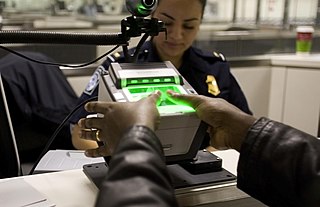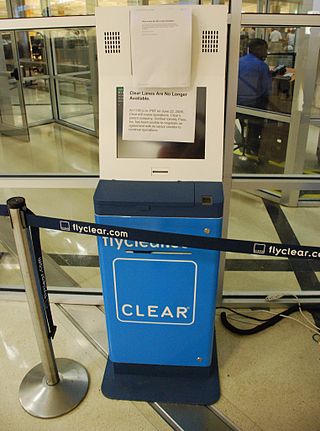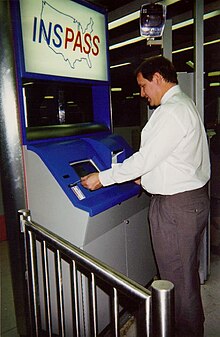
Border control comprises measures taken by governments to monitor and regulate the movement of people, animals, and goods across land, air, and maritime borders. While border control is typically associated with international borders, it also encompasses controls imposed on internal borders within a single state.

Antonio B. Won Pat International Airport, also known as Guam International Airport, is an international airport located in Tamuning and Barrigada, three miles (4.8 km) east of the capital city of Hagåtña in the United States territory of Guam. The airport is a hub for Asia Pacific Airlines and for United Airlines, serving as the latter's Pacific Ocean hub. It is also the home of the former Naval Air Station Agana, and is the only international airport in the territory. The airport is named after Antonio Borja Won Pat, the first delegate from Guam to the United States House of Representatives, and is operated by the A.B. Won Pat International Airport Authority, Guam, an agency of the Government of Guam.

In general, a port of entry (POE) is a place where one may lawfully enter a country. It typically has border security staff and facilities to check passports and visas and to inspect luggage to assure that contraband is not imported. International airports are usually ports of entry, as are road and rail crossings on a land border. Seaports can be used as ports of entry only if a dedicated customs presence is posted there. The choice of whether to become a port of entry is up to the civil authority controlling the port.

United States Visitor and Immigrant Status Indicator Technology is a U.S. Customs and Border Protection (CBP) management system. The system involves the collection and analysis of biometric data, which are checked against a database to track individuals deemed by the United States to be terrorists, criminals, and illegal immigrants. US-VISIT is accessed by 30,000 users from federal, state, and local government agencies. Upon Presidential approval of the 2013 Continuing resolution the US-VISIT program officially became the Office of Biometric Identity Management (OBIM), save for portions of the agency which performed overstay analysis being transferred into U.S. Immigration and Customs Enforcement and biometric Entry and Exit operations which became a part of U.S. Customs and Border Protection.

The United States Customs Service was a federal law enforcement agency of the U.S. federal government. Established on July 31, 1789, it collected import tariffs, performed other selected border security duties, as well as conducted criminal investigations.

A registered traveler is a person qualified through an airline passenger security assessment system in the United States air travel industry. Such programs were initially tested in 2005. Registered traveler programs are currently in operation in various airports around the country and are administered by TTAC, the Transportation Security Administration (TSA) office responsible for Secure Flight, the replacement for the Computer Assisted Passenger Prescreening System (CAPPS) and the canceled CAPPS II counter-terrorism system.

United States border preclearance is the United States Department of Homeland Security's (DHS) practice of operating prescreening border control facilities at airports and other ports of departure located outside of the United States pursuant to agreements between the United States and host countries. Travelers are subject to immigration and customs inspections by Customs and Border Protection (CBP) officers before boarding their transportation onward to the United States. Preclearance applies to all passengers regardless of their nationality or purpose of travel. Upon arrival, precleared passengers arrive in the United States as domestic travelers, but may still be subject to re-inspection at the discretion of CBP. This process is intended to streamline border procedures, reduce congestion at American ports of entry, and facilitate travel into airports that otherwise lack immigration and customs processing facilities for commercial flights.

The Office of Field Operations (OFO) is a federal law enforcement agency within the U.S. Customs and Border Protection (CBP) responsible for managing United States customs operations at 20 Field Operations offices, 328 ports of entry, and 16 pre-clearance stations in Canada, Ireland, the UAE, and the Caribbean. Headed by an Executive Assistant Commissioner, OFO directs the activities of more than 27,000 employees, including more than 22,000 CBP Officers and Agriculture Specialists. CBP Office of Field Operations is the largest component in CBP.

NEXUS is a joint Canada Border Services Agency and U.S. Customs and Border Protection-operated Trusted Traveler and expedited border control program designed for pre-approved, low-risk travelers. Members of the program can avoid waits at border entry points by using reserved lanes at land crossings into Canada and the United States, by using self-serve kiosks at airports in Canada, the US and some international locations, or by phoning border officials for a marine entry. A NEXUS membership card is a valid document under the Western Hemisphere Travel Initiative (WHTI), so it can be used in place of a passport, including by air if flying between the US and Canada. However, carrying a valid passport is still recommended, in the rare event that a flight is diverted to an airport without NEXUS support.
PISCES is a border control database system largely based on biometrics developed by Booz Allen Hamilton Inc..
The Port Passenger Accelerated Service System (PORTPASS) was a suite of programs of the former U.S. Immigration and Naturalization Service (INS), including:

The Secure Electronic Network for Travelers Rapid Inspection (SENTRI) provides expedited U.S. Customs and Border Protection (CBP) processing, at the U.S.-Mexico border, of pre-approved travelers considered low-risk. Voluntarily applicants must undergo a thorough background check against criminal, customs, immigration, law enforcement, and terrorist databases; a 10-fingerprint law enforcement check; and a personal interview with a CBP Officer. The total enrollment fee is $122.50, and SENTRI status is valid for 5 years.

Global Entry is a program of the U.S. Customs and Border Protection service that allows pre-approved, low-risk travelers to receive expedited clearance upon arrival into the United States through automatic kiosks at select airports and via the SENTRI and NEXUS lanes by land and sea. As of May 4, 2018, Global Entry was available at 53 U.S. airports and 15 preclearance locations. By April 2018 more than five million people were enrolled in Global Entry and approximately 50,000 new applications for the program were being filed each month.

The Remote Video Inspection System (RVIS) was deployed by United States in the late 1990s at select low-traffic border entry points from Canada. The system allowed passport and customs inspections to be conducted remotely, so that low-risk travelers could enter the country during hours that the border station did not have on-site staff. The system was successfully deployed at a number of entry points, in six different states. RVIS was discontinued following the September 11 attacks.
The Videophone Inspection Program (VIP) is a U.S. Customs and Border Protection program that enables boaters entering the United States from Canada to be inspected face-to-face by a CBP inspector upon arrival at a selected reporting station. The program was designed to facilitate the legal entry of pleasure boats into the United States that had not been issued a Form I-68.
Biometrics refers to the automated recognition of individuals based on their biological and behavioral characteristics, not to be confused with statistical biometrics; which is used to analyse data in the biological sciences. Biometrics for the purposes of identification may involve DNA matching, facial recognition, fingerprints, retina and iris scanning, voice analysis, handwriting, gait, and even body odor.

Cross Border Xpress (CBX) is a border crossing and port of entry that connects San Diego in the United States and Tijuana International Airport in Mexico. Operational since December 2015, CBX consists of a terminal building located in the Otay Mesa community that is connected to the airport with a dedicated 120-meter (390 ft) pedestrian bridge that travels over the United States–Mexico border.
Programa Viajero Confiable is a Mexican trusted traveler program which allows members to pass securely through customs and immigration controls in reduced time, using automated kiosks at participating airports. Programa Viajero Confiable, a Western Hemisphere Travel Initiative (WHTI) program, was introduced in three airports in 2014 and has since expanded to additional sites.

Automated border control systems (ABC) or eGates are automated self-service barriers which use data stored in a chip in biometric passports along with a photo or fingerprint taken at the time of entering the eGates to verify the passport holder's identity. Travellers undergo biometric verification using facial or iris recognition, fingerprints, or a combination of modalities. After the identification process is complete and the passport holder's identity is verified, a physical barrier such as a gate or turnstile opens to permit passage. If the passport holder's identification is not verified or if the system malfunctions, then the gate or turnstile does not open and an immigration officer will meet the person. E-gates came about in the early 2000s as an automated method of reading the then-newly ICAO mandated e-passports.
Mobile Passport Control (MPC) is a mobile app that enables eligible travelers entering the United States to submit their passport information and customs declaration form to Customs and Border Protection via smartphone or tablet and go through the inspections process using an expedited lane. It is available to "U.S. citizens, U.S. lawful permanent residents, Canadian B1/B2 citizen visitors and returning Visa Waiver Program travelers with approved ESTA".














